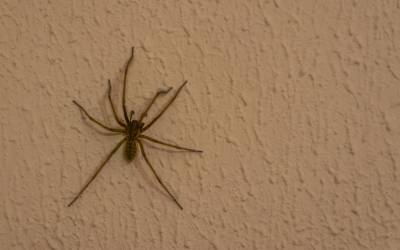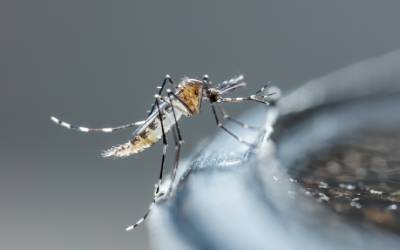When you see a spider in your house, the first thing you probably do is ask yourself if it’s dangerous. There are more than four thousand spider species in North America, and while most are harmless to humans, a few are venomous enough to pose a threat. Here in the greater St. Louis area where we operate, the species you’re most likely to encounter in your home is the common house spider, also known as the American house spider.
What Does the Common House Spider Look Like?
Common house spiders have drab coloring overall: yellowish, tan, brown, or gray, with darker mottling or streaks. They have a round abdomen, with bodies that are higher than they are long, and usually include streaks on the side and V-shapes behind. Often, a whitish patch can be seen just behind the highest point of the abdomen. Their legs are usually ringed with a dark color. Females can range in length from 1/8″ to 3/8″ (not including legs). Males are smaller, typically only 1/8″.
Where Do House Spiders Live?
You can find the common house spider throughout the United States and southern Canada. They appreciate quiet, undisturbed areas where food and moisture are available. Gardens, basements, attics, barns, and sheds are some examples, but they’re not limited to those areas–they can be found pretty much anywhere. During the day, they like to reside in the safety of their webs. Their webs can be messy and asymmetrical with spirals of silk originating from a central point. Left alone, house spiders can live indoors for as long as seven years. Outside, female spiders die in the cold and males rarely live longer than a year.
Do House Spiders Bite Humans and Are They Dangerous?
House spiders are generally shy around humans. They prefer to run, hide, or play dead when they feel threatened. They likely will not go out of their way to attack, but if you do get bit, their bites are relatively harmless with just minor swelling and redness.
House spiders are not very dangerous at all, but people consider them a nuisance for the unsightly webs they leave or because they give them heeby-jeebies. If you’re considering house spider removal, it’s worthwhile to consider the benefits a house spider brings to a house. They help control the population of other household pests. Flies, mosquitoes, wasps, cockroaches, beetles and many others are all on the menu. So while you may not like seeing a spider in your home, it’s much more likely to help than hurt you.
Prevent House Spiders from Getting In
Spiders are everywhere and if they want to get into your house, it’s difficult to stop them. However, we do have a few helpful tips for minimizing the number of house spiders who call your house home.
- Keep the outside of your home tidy: Spiders often congregate around building exteriors. Removing firewood, stacked items, and debris away from the foundation helps reduce indoor migration. Shrubs, vines, and tree limbs touching the house should also be trimmed back since these afford spiders a convenient bridge to the structure.
- Seal cracks and crevices: Inspect your home’s exterior, paying attention to any cracks or crevices around doors and windows. These openings provide an easy way for spiders to get inside. Seal them with caulk or weatherstripping.
- Keep your house clean: A tidy house is less attractive to spiders than a cluttered one. Regularly sweeping and vacuuming will help to remove spider webs, eggs, and insects that spiders feed on. In addition, keep food stored properly in sealed containers to avoid attracting pests because pests will attract spiders.
Trusted Spider Exterminators in St. Louis
Still want to get rid of the spiders in your home? It may be time to call a professional spider exterminator.
Blue Chip Pest Services has been your local spider pro in St. Louis since 1971. Contact us today for a free quote!



